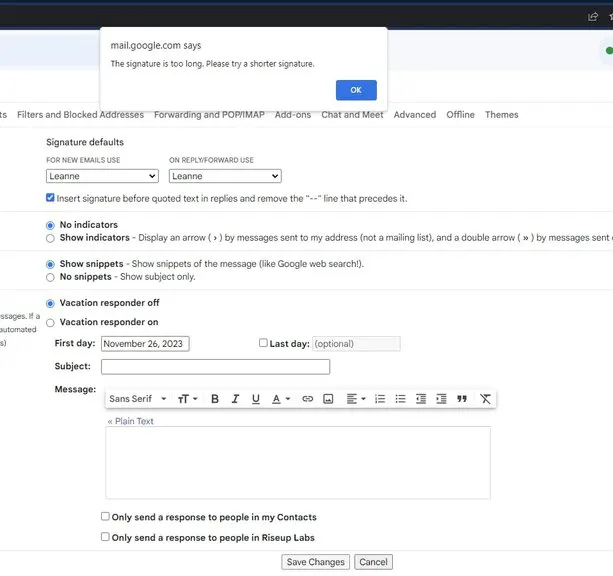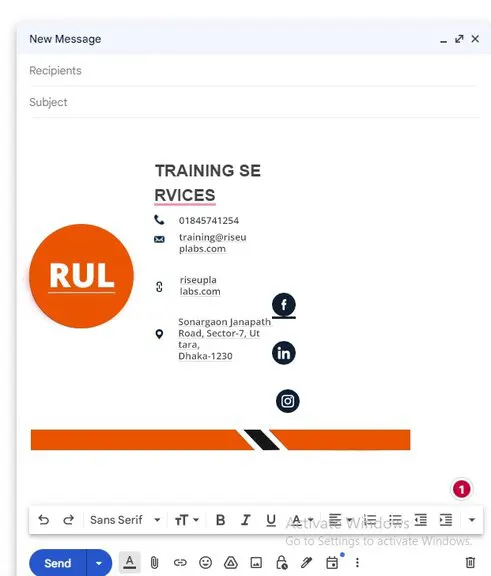Creating a custom email footer that satisfies your client’s design requirements can be a challenging endeavor, especially when faced with size limitations and compatibility issues. This technical case study details our journey to overcoming these challenges faced with email footer size limitations by transitioning from Google Docs to HTML. We’ll explore the problems we encountered, the solutions we implemented, and the tricks we employed to achieve success in delivering a unique email footer that met our client’s expectations.
Why Email Footers?
Email footers, often overlooked, serve as valuable branding and communication tools. When our client presented specific design requirements for a custom email footer, we initially attempted to create it in Google Docs and set it to email signature field settings. However, size limitations and compatibility issues quickly became evident, prompting us to seek alternative solutions. This case study delves into the technical challenges we encountered and the steps we took to resolve them.
Problem with Email Footer Size Limitations
Our initial attempt to design the custom email footer using Google Docs encountered size restrictions that prevented us from including all the desired elements, such as images, gifs, and links. Compressing the assets did not resolve the problem. To create an appealing and functional email footer, we needed to find a more flexible solution.


Transition to HTML
To overcome the limitations posed by Google Docs, we decided to develop the email footer using HTML. HTML offers greater flexibility and control over the design, allowing us to include various elements while adhering to email client constraints.
Technical Challenges in Handling Footer Size
Size Constraints: Email clients impose size limitations on email footers. Images, gifs, and links can quickly bloat the footer, causing compatibility issues.
Alignment Problems: Maintaining a consistent layout and alignment across different email clients can be a daunting task.
Using HTML to resolve Footer Size Limitations
HTML Coding: We shifted to HTML coding to have precise control over the elements within the email footer. Note that, the CSS was Inline and didn’t use an external CSS File.This allowed us to manage the size issue effectively.
<p
color="#000000"
font-size="medium"
class="job-title__Container-sc-1hmtp73-0 ifJNJc"
style="
margin: 0px;
color: #434343;
font-size: 14px;
line-height: 22px;
padding-bottom: 4px;
"
>
<span>Executive Projects and Compliance</span>
</p>
<table
cellpadding="0"
cellspacing="0"
class="table__StyledTable-sc-1avdl6r-0 kAbRZI"
style="
vertical-align: -webkit-baseline-middle;
font-size: medium;
font-family: Arial;
"
>Table-Based Layout: We utilized HTML tables and set their opacity to 0. This clever trick enabled us to create a responsive and flexible email footer that worked seamlessly across various email clients.
Copy the HTML Output: After completing the HTML code, we copy the HTML output to the email signature field settings.
Outcome of utilizing HTML for Footer Size
By implementing HTML coding with a table-based layout, we successfully designed a custom email footer and copied the HTML output to the signature field settings. That satisfied our client’s requirements and worked flawlessly across different email clients. The opacity trick ensured that the alignment remained consistent, and the email footer appeared as intended.

Recommendations
- When faced with email footer size limitations, consider transitioning to HTML for greater control over design elements.
- Utilize HTML tables and opacity adjustments to ensure consistent alignment across different email clients.
- After completing the HTML code, Copy the HTML output to the signature field settings.
- Regularly test the email footer in various email clients to ensure compatibility and functionality.
Conclusion
Developing a custom email footer that includes images, gifs, and links can be challenging due to email client limitations. Transitioning to HTML and employing a table-based layout with opacity adjustments proved to be a practical solution. This technical case study highlights the challenges we faced and the strategies we employed to create a functional and visually appealing custom email footer.
This technical case study summarizes the journey of overcoming size limitations and alignment issues when creating a custom email footer. It serves as a valuable resource for anyone facing similar challenges and looking for a practical solution to design visually appealing and functional email footers.
Coauthored By: Md Rajiur Rahman
This page was last edited on 19 December 2023, at 1:10 pm
How can we help you?
























